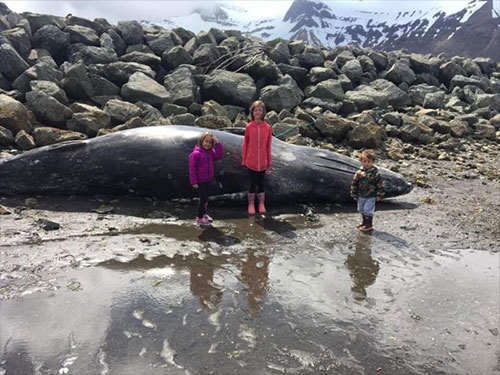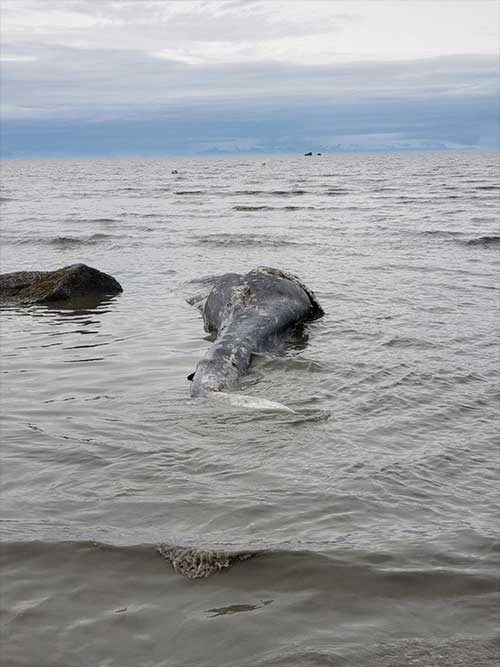
Elevated West Coast gray whale strandings declared an Unusual Mortality EventNOAA Fisheries confirms fifth dead gray whale in Alaska
June 01, 2019
Under the Marine Mammal Protection Act, an unusual mortality event (UME) is defined as "a stranding that is unexpected; involves a significant die-off of any marine mammal population; and demands immediate response." As of May 31, about 70 gray whales have stranded on the coasts of California, Oregon, Washington and Alaska so far this year, the most since 2000, when more than 100 whales stranded in what was also determined to be a Unusual Mortality Event. British Columbia and Mexico have also recorded gray whale strandings. The eastern North Pacific gray whale population that migrates along the Pacific Coast was last estimated at about 27,000 animals. On May 28, 2019, NOAA Fisheries received a report of a dead gray whale in Chignik Bay, a community on the southern side of the Alaska Peninsula. The whale was first observed alive in an unusual location under the community's dock. It was then observed dead on May 25, and towed to a beach away from town due to concerns about attracting bears. NOAA Fisheries reported they are attempting to gather more information and coordinate with community members to secure the carcass and, if possible, conduct a necropsy to collect samples, measurements, and ascertain cause of death. This is Alaska's 5th confirmed dead gray whale in 2019. Alaska typically sees between 0-3 gray whale strandings from the first of January to the end of May, based on the past 18 years. In 2000, the number in the January-May timeframe was 18.
A family fishing for herring north of the Clam Gulch Recreation Area on the Kenai Peninsula last Wednesday, May 25th, also discovered a dead whale, this was the fourth dead whale reported in May in Alaska. They reported this stranding to NOAA Fisheries Friday a week ago with a photograph. Marine mammal experts examined the family’s photo of the whale and confirmed the stranding was another gray whale. It is the fourth dead gray whale confirmed in Alaska this year.
The estimated length of the Clam Gulch whale is 20-24 feet. Gray whale calves are born at about 15 feet, so this is a young whale. From photos, Alaska Veterinary Pathology Services Pathologist Dr. Kathy Burek Huntington notes, “it is a small, super skinny whale.” NOAA hopes to perform a necropsy on the gray whale, but that is not likely until Cook Inlet has minus tides, as the whale is on a sandbar that is only exposed at extreme low tides. The minus tides must be low enough for the necropsy team to collect tissue samples. Unusual Mortality Event (UME) Understanding and investigating marine mammal unusual mortality events is crucial because they can be indicators of ocean health, giving insight into larger environmental issues which may also have implications for human health. To fill this role, NOAA Fisheries established the Working Group on Marine Mammal Unusual Mortality Events in 1991. The working group was formalized in 1992 with amendments to the MMPA amendments. The working group members are comprised of experts from scientific and academic institutions, conservation organizations, state and federal agencies who work closely with stranding networks and have a wide variety of experience in biology, toxicology, pathology, ecology, and epidemiology. Core members are appointed for three-year terms and have voting privileges. International participants and federal government representatives contribute significantly throughout the UME investigations but do not have voting rights. An UME is determined to be "unusual" by the working group if it meets one or more of the seven criteria.
Any of these criteria may indicate an unusual mortality event. All possible information is reviewed and, within 24 hours of the initial consultation, it is decided whether an event is considered an UME. The Marine Mammal Unusual Mortality Event Contingency Fund is used to help the marine mammal stranding network investigate and respond to UMEs. You can donate to the UME Contingency Fund through Pay.gov and help cover costs incurred by the Marine Mammal Stranding Network while investigating UMEs.
Related:
Reported & Edited by Mary Kauffman, SitNews
Source of News:
|
|||||

